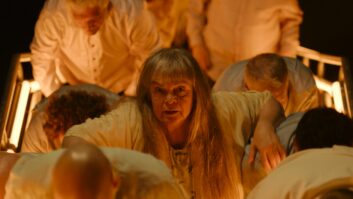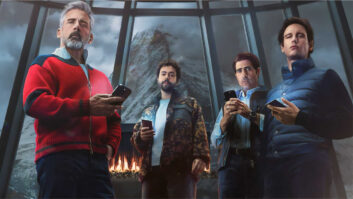After honing his craft at prestigious facilities like Molinare, Twickenham Film Studios and Dirty Looks, Tom Cairns is now one of the go-to guys for beautiful and varied grades for some of the most exciting directors and DoPs in the game. He recently launched Brick and Mortar, a new boutique facility in Glasgow, where he heads up the colour department and continues to work on a wide range of content.
Cairns’ credits include Chris Andrews’ Bring Them Down (2025) for Mubi, led by Barry Keoghan and Christopher Abbott, Moin Hussain’s Sky Peals (2023) for BFI & Film4, and Rapman’s Blue Story (2019) for BBC and Paramount.
He explains why he wanted to create Scotland’s only grading theatre, the technology he uses to create the look of TV series and films, and advice for aspiring colourists.

Tell us about your journey to becoming a successful colourist.
I realised very early on that I was not going to be able to pursue a career in something that I wasn’t passionate about. My obsession with film led me to film school, where I pretty much thought I would go and see what stuck. That was great and I learnt a huge amount, but when I left I was still really none the wiser about what to do.
I had one or two false starts in London before I found myself as a runner in a big broadcast post house, Prime Focus, where I had the vague hopes of becoming an editor. I was very lucky to be guided by some truly excellent management and colleagues, who all put a huge amount of time and effort into the support, training and progression of their staff. I made my way through offline, then online assisting – progressing, but still unsure what direction I was going. Then, one day, I got introduced to the grading suite, helmed at the time by Alex Gascoigne and Kevin Horsewood, and my eyes were opened to the possibilities of what could be achieved. It was a ‘stars aligning’ moment for me.
From there, I joined Molinare’s DI team, working on projects like Ex Machina, The Crown, Doctor Who, and Brooklyn. It was a big step up and further solidified that this was what I wanted to do. I spent every moment I could sitting in on grades, training, and grading as many shorts or music videos as I could get my hands on.
After some great years at Twickenham and Dirty Looks, I made the decision to move to Glasgow, and shortly after meeting some like-minded people passionate about Scotland’s potential, we decided to set up Brick and Mortar and launched at Berlinale in 2024.
So far, I think I have graded close to 40 films, but I still feel I’m just at the start of my career, and very excited about what is yet to come.

Tell us more about Brick and Mortar.
Brick and Mortar (BaM) is a boutique, artist-led post production company based in Glasgow, focusing on offline editorial, colour grading and picture finishing for feature film, drama and commercials. The facility recently benefited from substantial investment in new suites and infrastructure, including the crucial addition of Baselight grading systems and Scotland’s first and only DCI-compliant grading theatre.
After working at a couple of the most well-known, large and smaller scale post houses, my takeaway has always been that the common thread to successful and enjoyable work is a very personal, collaborative approach, that breeds the best creativity and results. For this reason, BaM is an intimate, scalable and powerful editorial and colour team, promoting a tailor made, personal environment where directors and DoPs can put their images in safe hands and create their best work.
Why open Scotland’s only grading theatre?
On coming to Scotland one of the things that hit me, aside from the incredible wealth of talent in production and post, was the glaring omission of a grading theatre to service all the wonderful film work that is made here. As we explored the potential of a new post house, and pairing it with top of the range film and commercial talent as well as Scotland’s only grading theatre, we realised we could not only give the talent in Scotland the option to finish locally, but also offer a standard that encourages creatives around the country and the world to bring their grades here.

I head up the colour department at BaM and take the creative lead on all things colour, workflow, development, and bringing on new colour talent. I am lucky to be able to work on a wide range of content, including features, drama, documentaries and commercials.
Why the decision to use Baselight?
I’ve been grading on Baselight for just over 13 years and I’ve come to take for granted the rock-solid colour management, and incredible support from the FilmLight team.
Ergonomically and functionally, with both the interface and the controls, I’ve always enjoyed the experience of grading using Baselight. It always feels intuitive and efficient, with endless scope for new ways to push things. This breeds confidence in the operator, which, in turn, relaxes the experience for everyone in the room – no matter how demanding the grade can be.
I have been so impressed with the Chromogen tool so far. I feel I am only scratching the surface of the possibilities, but within moments and in just a small number of stages, you can create such powerful looks that roll off without any harshness. The possibilities do truly feel endless. Including Chromogen look development as a norm in the look setting stage with DoPs is something I am very keen to push for and I think will be very exciting for them.
To this day I am still experimenting with new tools and combinations to enhance the storytelling and experience of the image. The involvement of the FilmLight team to push the possibilities forward brings an exciting feeling of originality and exploration to every project.
From the point of view of a boutique facility, much like our adoption of the grading theatre, Baselight is a beast that lets us punch well above our weight compared to other similar-sized facilities.
What advice would you give to aspiring colourists?
First and foremost, as always, is just grade as much as you can, on whatever you can.
Secondly, know that the relationships that you form in the industry are invaluable – whether that’s with clients or colleagues. Work hard for them and always be dependable.
Finally, it is very important at the start to focus on shot matching and the basics, and developing looks can come later, but I would also always encourage them to be bold, experiment and make mistakes. Go too far and learn how to bring it back. Find what bit of image manipulation excites you the most and keep at it.
What are you working on now/next?
I’ve just finished up on a heist and psychological thriller film starring Sam Claflin and Eddie Marsan called All The Devils Are Here, directed by Barnaby Roper. Followed up next by Paul Wright’s new film, set here in Glasgow and starring George MacKay, called Mission. I have no idea how to fit this one into a genre, but it looks a huge amount of fun to work on.







